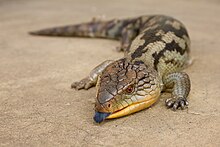| Blue-tongued skinks | |
|---|---|

| |
| Blotched blue-tongued skink (Tiliqua nigrolutea) | |
| Scientific classification | |
| Domain: | Eukaryota |
| Kingdom: | Animalia |
| Phylum: | Chordata |
| Class: | Reptilia |
| Order: | Squamata |
| Family: | Scincidae |
| Subfamily: | Egerniinae |
| Genus: | Tiliqua Gray, 1825[1] |
| Species | |
|
8 extant, see text. | |
| Synonyms | |
|
Trachydosaurus | |
Blue-tongued skinks[2] comprise the Australasian genus Tiliqua, which contains some of the largest members of the skink family (Scincidae). They are commonly called blue-tongued lizards or simply blue-tongues or blueys in Australia or panana in Indonesia. As suggested by these common names, a prominent characteristic of the genus is a large blue tongue that can be bared as bluff-warning to potential enemies.[3] The type of predator/threat that is near will determine the intensity of colour present in the tongue. The tongue can also deform itself and produce a thick mucus in order to catch prey.[4] They are relatively shy in comparison with other lizards, and also significantly slower due to their shorter legs.
- ^ Gray, J.E. (1825). A synopsis of the genera of reptiles and Amphibia, with a description of some new species. Annals of Philosophy 10:193—217. p. 201
- ^ Tiliqua, Reptile Database
- ^ Abramjan, Andran (2015). "Why is the tongue of blue-tongued skinks blue? reflectance of lingual surface and its consequences for visual perception by conspecifics and Predators". The Science of Nature. 102 (7–8): 42. Bibcode:2015SciNa.102...42A. doi:10.1007/s00114-015-1293-4. PMID 26185113. S2CID 16915899.
- ^ Tamara L. Smith; Kenneth V. Kardong; Vincent L. Bels (1999). "Prey Capture Behavior in the Blue-tongued Skink, Tiliqua scincoides" (PDF). Journal of Herpetology. 33 (3): 362–369. doi:10.2307/1565632. JSTOR 1565632. Retrieved 24 May 2022.